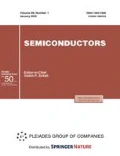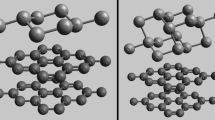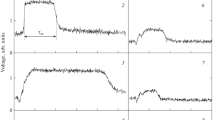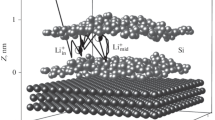Abstract
The radiation doping of single-crystal silicon with phosphorus retains the structure of the sample, reduces internal stresses, and increases the lifetime of minority charge carriers. The study is concerned with the effect of phosphorus additives on the electronic properties of silicene. The electron density-of-states spectra of a phosphorus-doped single layer and 2 × 2 bilayer silicene on a graphite substrate are calculated by the quantum-mechanical method. The carbon substrate imparts semiconductor properties to silicene due to p–p hybridization. Doping with phosphorus can retain or modify the metal properties gained by silicene. The position of phosphorus dopant atoms in silicene influences the semiconductor–conductor transition. The theoretical specific capacity of a phosphorus-doped silicene electrode decreases, and the electrode becomes less efficient for application in lithium-ion batteries. However, the increase in the conductivity is favorable for use of this material in solar cells.





Similar content being viewed by others
REFERENCES
A. G. Aberle, Thin Solid Films 517, 4706 (2009).
A. V. Isakov, A. P. Apisarov, A. O. Khudorozhkova, M. V. Laptev, and Yu. P. Zaikov, J. Phys.: Conf. Ser. 1134, 012021 (2018).
S. I. Zhuk, L. M. Minchenko, O. V. Chemezov, V. B. Malkov, O. V. Grishenkova, V. A. Isaev, Yu. P. Zaikov, and Sh. Qi, Adv. Mater. Res. 1088, 429 (2015).
M. N. Andreev, A. K. Rebrov, A. I. Safonov, N. I. Timoshenko, K. V. Kubrak, and V. S. Sulyaeva, J. Eng. Phys. Thermophys. 88, 1003 (2015).
M. Moreno and P. Roca i Cabarrocas, EPJ Photovolt. 1, 10301 (2010).
P. Vogt, P. De Padova, C. Quaresima, J. Avila, E. Frantzeskakis, M. C. Asensio, A. Resta, B. Ealet, and G. L. Lay, Phys. Rev. Lett. 108, 155501 (2012).
D. Chiappe, C. Grazianetti, G. Tallarida, M. Fanciulli, and A. Molle, Adv. Mater. 24, 5088 (2012).
A. Fleurence, R. Friedlein, T. Ozaki, H. Kawai, Y. Wang, and Y. Takamura, Phys. Rev. Lett. 108, 245501 (2012).
L. Meng, Y. Wang, L. Zhang, S. Du, R. Wu, L. Li, Y. Zhang, G. Li, H. Zhou, W. A. Hofer, and M. J. Gao, Nano Lett. 13, 685 (2013).
Y. Ding and Y. Wang, Nanoscale Res. Lett. 10, 13 (2015).
A. Kara, H. Enriquez, A. P. Seitsonen, L. C. L. Y. Voon, S. Vizzini, B. Aufray, and H. Oughaddou, Surf. Sci. Rep. 67, 1 (2012).
H. Nakano, Y. Sugiyama, T. Morishita, M. J. S. Spencer, I. K. Snook, Y. Kumai, and H. Okamoto, J. Mater. Chem. A 2, 7588 (2014).
M. de Crescenzi, I. Berbezier, M. Scarselli, P. Castrucci, M. Abbarchi, A. Ronda, F. Jardali, J. Park, and H. Vach, ACS Nano 10, 11163 (2016).
J. Zhao, H. Liu, Z. Yu, R. Quhe, S. Zhou, Y. Wang, C. C. Liu, H. Zhong, N. Han, J. Lu, Y. Yao, and K. Wu, Progr. Mater. Sci. 83, 24 (2016).
A. E. Galashev, O. R. Rakhmanova, K. A. Ivanichkina, and A. S. Vorob’ev, Phys. Solid State 59, 1242 (2017).
A. E. Galashev, O. R. Rakhmanova, and K. A. Ivanichkina, J. Struct. Chem. 59, 877 (2018).
H. Q. Ho, Y. Honda, M. Motoyama, S. Hamamoto, T. Ishii, and E. Ishitsuka, Appl. Radiat Isot. 135, 12 (2018).
M. L. Kozhukh, Nucl. Instrum. Methods Phys. Res., Sect. A 329, 453 (1993).
I. S. Shlimak, Phys. Solid State 41, 716 (1999).
J. M Soler, E. Artacho, J. D. Gale, A. García, J. Junquera, P. Ordejon, and D. Sanchez-Portal, J. Phys.: Condens. Matter 14, 2745 (2002).
W. Hu, Z. Li, and J. Yang, J. Chem. Phys. 139, 154704 (2013).
S. K. Gupta, H. R. Soni, and P. K. Jha, AIP Adv. 3, 032117 (2013).
N. Pantha, A. Khaniya, and N. P. Adhikari, Int. J. Mod. Phys. B 29, 1550143 (2015).
S. Xu, X. Fan, J. Liu, D. J. Singh, Q. Jiang, and W. Zheng, Phys. Chem. Chem. Phys. 20, 8887 (2018).
T. Hussain, S. Chakraborty, and R. Ahuja, Chem. Phys. Chem. 14, 3463 (2013).
M. A. Bin Hamid, C. K. Tim, Y. Bin Yaakob, and M. A. Bin Hazan, Mater. Res. Express 6 (5) (2019).
R. Zhou, L. C. L. Y. Voon, and Y. Zhuang, J. Appl. Phys. 114, 093711 (2013).
J. E. Padilha and R. B. Pontes, J. Phys. Chem. C 119, 3818 (2015).
J. Sivek, H. Sahin, B. Partoens, and F. M. Peeters, Phys. Rev. B 87, 085444 (2013).
T. L. Brown, H. E. LeMay, and B. E. Bursten, J. Chem. Educat. 74 (4) (1997).
M. S. Silberberg, Chemistry: The Molecular Nature of Matter and Change, 5th ed. (McGraw-Hill, New York, 2009).
A. Y. Galashev and Yu. P. Zaikov, J. Appl. Electrochem. 49, 1027 (2019).
W. Liu, H. Zhi, and X. Yu, Energy Storage Mater. 16, 290 (2019).
A. E. Galashev, Yu. P. Zaikov, and R. G. Vladykin, Russ. J. Electrochem. 52, 966 (2016).
Funding
The study was supported by the Russian Science Foundation, project no. 16-13-00061.
Author information
Authors and Affiliations
Corresponding author
Ethics declarations
The authors declare that they have no conflict of interest.
Additional information
Translated by E. Smorgonskaya
Rights and permissions
About this article
Cite this article
Galashev, A.E., Vorob’ev, A.S. Electronic Properties of Silicene Films Subjected to Neutron Transmutation Doping. Semiconductors 54, 641–649 (2020). https://doi.org/10.1134/S1063782620060068
Received:
Revised:
Accepted:
Published:
Issue Date:
DOI: https://doi.org/10.1134/S1063782620060068




